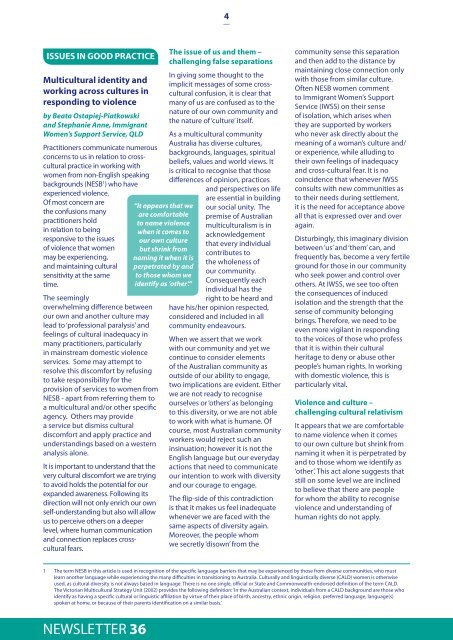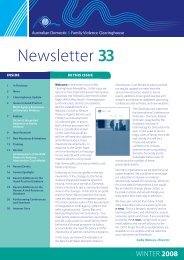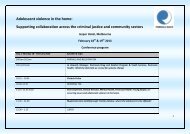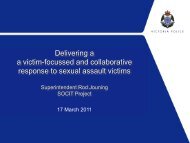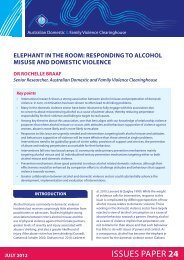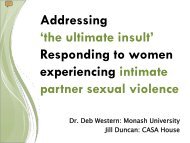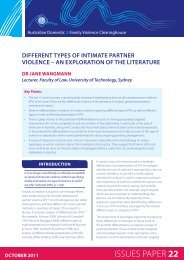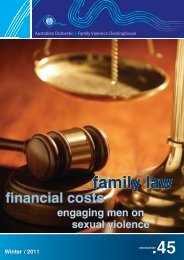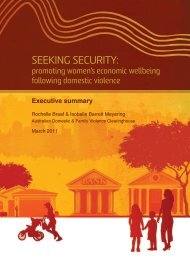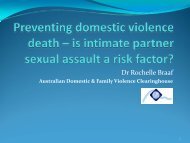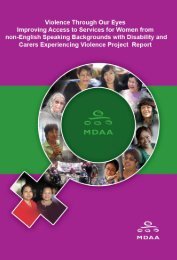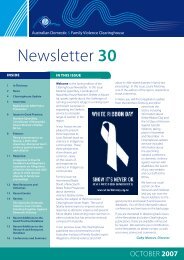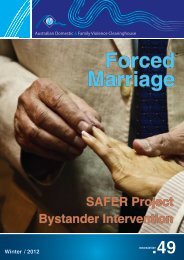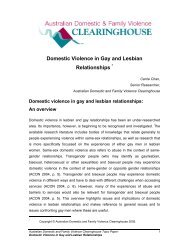newsletter - Australian Domestic and Family Violence Clearing House
newsletter - Australian Domestic and Family Violence Clearing House
newsletter - Australian Domestic and Family Violence Clearing House
You also want an ePaper? Increase the reach of your titles
YUMPU automatically turns print PDFs into web optimized ePapers that Google loves.
4<br />
ISSUES IN GOOD PRACTICE<br />
Multicultural identity <strong>and</strong><br />
working across cultures in<br />
responding to violence<br />
by Beata Ostapiej-Piatkowski<br />
<strong>and</strong> Stephanie Anne, Immigrant<br />
Women’s Support Service, QLD<br />
Practitioners communicate numerous<br />
concerns to us in relation to crosscultural<br />
practice in working with<br />
women from non-English speaking<br />
backgrounds (NESB 1 ) who have<br />
experienced violence.<br />
Of most concern are<br />
the confusions many<br />
practitioners hold<br />
in relation to being<br />
responsive to the issues<br />
of violence that women<br />
may be experiencing,<br />
<strong>and</strong> maintaining cultural<br />
sensitivity at the same<br />
time.<br />
The seemingly<br />
overwhelming difference between<br />
our own <strong>and</strong> another culture may<br />
lead to ‘professional paralysis’ <strong>and</strong><br />
feelings of cultural inadequacy in<br />
many practitioners, particularly<br />
in mainstream domestic violence<br />
services. Some may attempt to<br />
resolve this discomfort by refusing<br />
to take responsibility for the<br />
provision of services to women from<br />
NESB - apart from referring them to<br />
a multicultural <strong>and</strong>/or other specific<br />
agency. Others may provide<br />
a service but dismiss cultural<br />
discomfort <strong>and</strong> apply practice <strong>and</strong><br />
underst<strong>and</strong>ings based on a western<br />
analysis alone.<br />
It is important to underst<strong>and</strong> that the<br />
very cultural discomfort we are trying<br />
to avoid holds the potential for our<br />
exp<strong>and</strong>ed awareness. Following its<br />
direction will not only enrich our own<br />
self-underst<strong>and</strong>ing but also will allow<br />
us to perceive others on a deeper<br />
level, where human communication<br />
<strong>and</strong> connection replaces crosscultural<br />
fears.<br />
“It appears that we<br />
are comfortable<br />
to name violence<br />
when it comes to<br />
our own culture<br />
but shrink from<br />
naming it when it is<br />
perpetrated by <strong>and</strong><br />
to those whom we<br />
identify as ‘other’.”<br />
The issue of us <strong>and</strong> them –<br />
challenging false separations<br />
In giving some thought to the<br />
implicit messages of some crosscultural<br />
confusion, it is clear that<br />
many of us are confused as to the<br />
nature of our own community <strong>and</strong><br />
the nature of ‘culture’ itself.<br />
As a multicultural community<br />
Australia has diverse cultures,<br />
backgrounds, languages, spiritual<br />
beliefs, values <strong>and</strong> world views. It<br />
is critical to recognise that those<br />
differences of opinion, practices<br />
<strong>and</strong> perspectives on life<br />
are essential in building<br />
our social unity. The<br />
premise of <strong>Australian</strong><br />
multiculturalism is in<br />
acknowledgement<br />
that every individual<br />
contributes to<br />
the wholeness of<br />
our community.<br />
Consequently each<br />
individual has the<br />
right to be heard <strong>and</strong><br />
have his/her opinion respected,<br />
considered <strong>and</strong> included in all<br />
community endeavours.<br />
When we assert that we work<br />
with our community <strong>and</strong> yet we<br />
continue to consider elements<br />
of the <strong>Australian</strong> community as<br />
outside of our ability to engage,<br />
two implications are evident. Either<br />
we are not ready to recognise<br />
ourselves or ‘others’ as belonging<br />
to this diversity, or we are not able<br />
to work with what is humane. Of<br />
course, most <strong>Australian</strong> community<br />
workers would reject such an<br />
insinuation; however it is not the<br />
English language but our everyday<br />
actions that need to communicate<br />
our intention to work with diversity<br />
<strong>and</strong> our courage to engage.<br />
The flip-side of this contradiction<br />
is that it makes us feel inadequate<br />
whenever we are faced with the<br />
same aspects of diversity again.<br />
Moreover, the people whom<br />
we secretly ‘disown’ from the<br />
community sense this separation<br />
<strong>and</strong> then add to the distance by<br />
maintaining close connection only<br />
with those from similar culture.<br />
Often NESB women comment<br />
to Immigrant Women’s Support<br />
Service (IWSS) on their sense<br />
of isolation, which arises when<br />
they are supported by workers<br />
who never ask directly about the<br />
meaning of a woman’s culture <strong>and</strong>/<br />
or experience, while alluding to<br />
their own feelings of inadequacy<br />
<strong>and</strong> cross-cultural fear. It is no<br />
coincidence that whenever IWSS<br />
consults with new communities as<br />
to their needs during settlement,<br />
it is the need for acceptance above<br />
all that is expressed over <strong>and</strong> over<br />
again.<br />
Disturbingly, this imaginary division<br />
between ‘us’ <strong>and</strong> ‘them’ can, <strong>and</strong><br />
frequently has, become a very fertile<br />
ground for those in our community<br />
who seek power <strong>and</strong> control over<br />
others. At IWSS, we see too often<br />
the consequences of induced<br />
isolation <strong>and</strong> the strength that the<br />
sense of community belonging<br />
brings. Therefore, we need to be<br />
even more vigilant in responding<br />
to the voices of those who profess<br />
that it is within their cultural<br />
heritage to deny or abuse other<br />
people’s human rights. In working<br />
with domestic violence, this is<br />
particularly vital.<br />
<strong>Violence</strong> <strong>and</strong> culture –<br />
challenging cultural relativism<br />
It appears that we are comfortable<br />
to name violence when it comes<br />
to our own culture but shrink from<br />
naming it when it is perpetrated by<br />
<strong>and</strong> to those whom we identify as<br />
‘other’. This act alone suggests that<br />
still on some level we are inclined<br />
to believe that there are people<br />
for whom the ability to recognise<br />
violence <strong>and</strong> underst<strong>and</strong>ing of<br />
human rights do not apply.<br />
1 The term NESB in this article is used in recognition of the specific language barriers that may be experienced by those from diverse communities, who must<br />
learn another language while experiencing the many difficulties in transitioning to Australia. Culturally <strong>and</strong> linguistically diverse (CALD) women is otherwise<br />
used, as cultural diversity is not always based in language. There is no one single, official or State <strong>and</strong> Commonwealth-endorsed definition of the term CALD.<br />
The Victorian Multicultural Strategy Unit (2002) provides the following definition: ‘In the <strong>Australian</strong> context, individuals from a CALD background are those who<br />
identify as having a specific cultural or linguistic affiliation by virtue of their place of birth, ancestry, ethnic origin, religion, preferred language, language(s)<br />
spoken at home, or because of their parents identification on a similar basis.’<br />
<strong>newsletter</strong> 36


